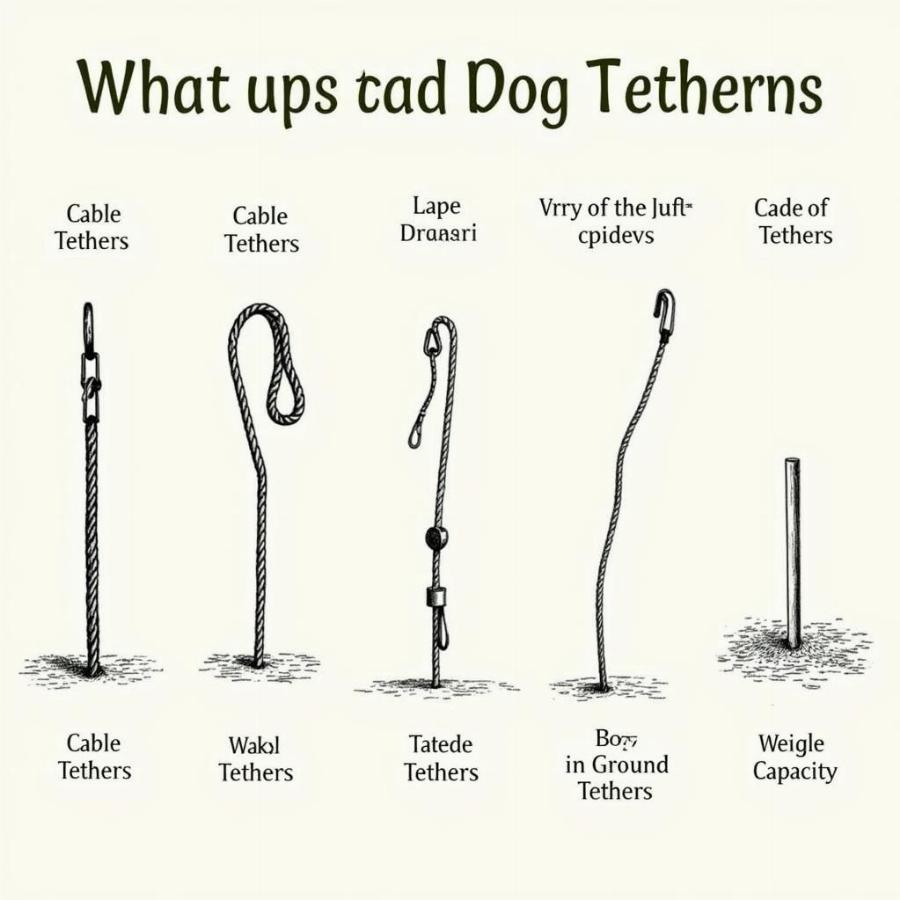Dog tethers for yards offer a convenient way to give your furry friend some fresh air and exercise. However, choosing the right tether and using it responsibly is crucial for your dog’s safety and well-being. This guide will cover everything you need to know about dog tethers, from selecting the appropriate type to ensuring your dog has a positive outdoor experience.
Choosing the Right Dog Tether
There’s no one-size-fits-all solution when it comes to dog tethers. The ideal tether depends on your dog’s size, breed, temperament, and your yard’s layout. For larger, more energetic breeds, a heavy-duty cable tether might be necessary, while a lighter rope tether might suffice for smaller, calmer dogs. Always prioritize tethers made from durable, weather-resistant materials that can withstand your dog’s strength and the elements. Avoid retractable tethers as they can pose a strangulation hazard and can easily break.
For dogs who like to chew, consider a chew-proof tether made from coated steel cable. These tethers are designed to withstand even the most determined chewers, ensuring your dog’s safety and the longevity of the tether. Remember, a proper tether isn’t just about restraint; it’s about providing a safe and comfortable outdoor experience.
 Different Types of Dog Tethers for Yards
Different Types of Dog Tethers for Yards
Setting Up Your Dog’s Tether Area
The location and setup of your dog’s tether area are just as important as the tether itself. Choose a shaded area to protect your dog from the sun and overheating, especially during warmer months. Ensure the area is free of potential hazards like sharp objects, poisonous plants, and anything your dog could ingest or become entangled in.
The tether should be long enough to allow your dog to move around comfortably and explore, but not so long that they can reach dangerous areas like roads or fences they could jump. A good rule of thumb is to allow enough length for your dog to reach their water bowl and a designated potty area.
Ensuring Your Dog’s Safety and Well-being
Never leave your tethered dog unsupervised for extended periods. Regularly check on them to ensure they have fresh water, aren’t tangled, and are comfortable. Tethering should be used in moderation and should never replace regular walks and playtime. A tethered dog can become bored and frustrated, so providing enrichment like chew toys or puzzle feeders can help keep them entertained.
What are the signs of a dog experiencing stress while tethered? Excessive barking, whining, pacing, and attempts to escape the tether area can indicate stress. If you observe any of these behaviors, bring your dog inside and consider alternative ways to provide them with outdoor time.
What to Consider Before Using a Dog Tether?
Thinking of using a dog tether? Consider your dog’s personality. Is your dog generally calm and comfortable being alone outside, or do they become anxious when separated from you? A tether might not be suitable for dogs prone to separation anxiety or excessive barking. Also, check local ordinances regarding tethering as some areas have restrictions on tethering duration or even prohibit it altogether.
What are the benefits of a swivel clip on a dog tether?
Swivel clips prevent the tether from becoming twisted and tangled, allowing your dog greater freedom of movement and reducing the risk of entanglement. They also help distribute the force of any sudden movements, minimizing strain on the tether and your dog’s collar or harness.
Conclusion
Dog tethers for yards can be a useful tool for providing your dog with supervised outdoor time. However, responsible usage is key. By choosing the right tether, setting up a safe and comfortable environment, and prioritizing your dog’s well-being, you can ensure a positive and safe outdoor experience for your furry friend. Remember, a tether should never be a substitute for regular exercise and interaction.
FAQ
- How long can I leave my dog tethered outside? It’s generally recommended to avoid leaving a dog tethered for extended periods. Frequent checks and limited duration are crucial.
- What type of tether is best for a chewer? Chew-proof tethers made from coated steel cable are the best option for dogs who like to chew.
- Can I use a tether instead of walking my dog? No, tethering should not replace regular walks and playtime.
- What should I do if my dog seems stressed while tethered? Bring your dog inside and consider other options for outdoor time.
- Are there any legal restrictions on dog tethering? Check your local ordinances as some areas have specific regulations regarding dog tethering.
- What’s the best length for a dog tether? The ideal length depends on your yard and dog’s size, but generally, it should allow movement without reaching hazards.
- How can I make my dog’s tethered area more enjoyable? Provide shade, water, and enrichment like chew toys or puzzle feeders.
Further Reading
- 6mm dog tie out 40ft
- Dog Tie Out Cable
Beaut Dogs is your go-to resource for all things dog-related, offering expert advice and guidance on dog breeds, care, and products. From understanding your dog’s unique needs to finding the perfect accessories, Beaut Dogs is here to help you navigate the wonderful world of dog ownership. When you need assistance, email us at [email protected] to get detailed and accurate answers from Beaut Dogs.